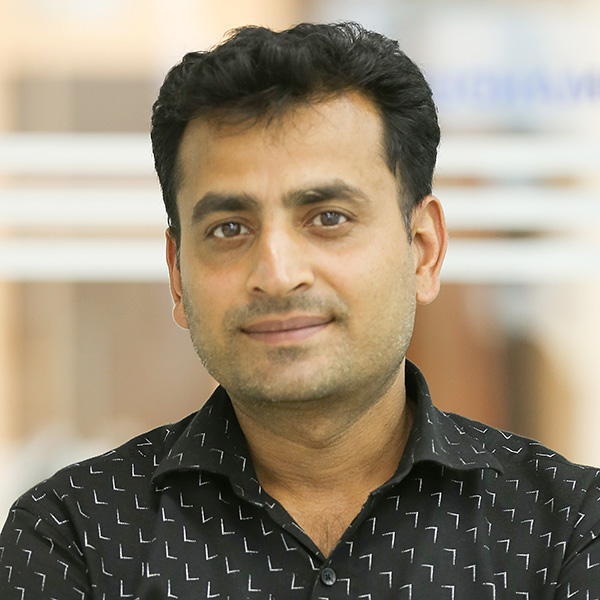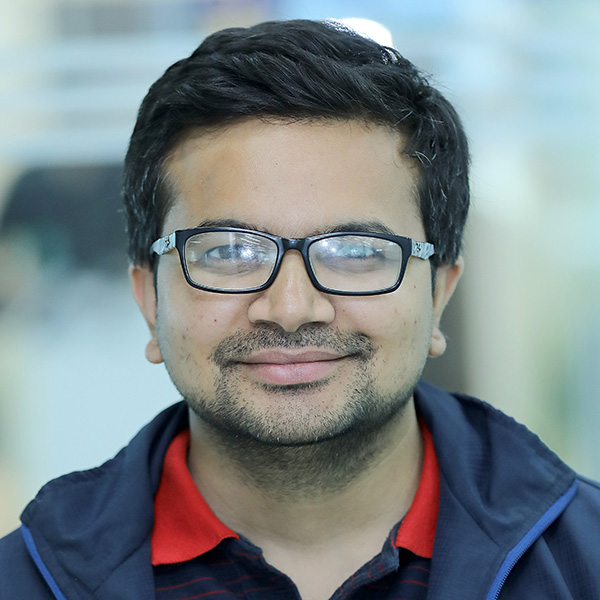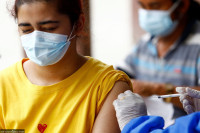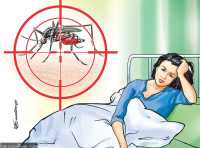Health
Complacency, miscalculation and missteps
Country records highest daily coronavirus death toll and new cases. Oli’s chest-thumping and false claims continue as vaccine supply is nowhere in sight. 47 percent of total tests return positive results.
Arjun Poudel & Binod Ghimire
When Nepal reported no death from Covid-19 on January 28, the first time in six months, it was the second day of the country’s vaccination drive. The country reported 213 new Covid-19 cases, a massive drop from the peak of 5,743 cases that it had reached last year on October 21. A day before no death was reported since August, on January 27, while launching the vaccination drive, Prime Minister KP Sharma Oli made a tall claim–that all the citizens would be inoculated “within three months.”
It has been a little over three months since he made the statement.
On Tuesday, the country reported the highest ever single-day toll with 55 deaths and record high number of new cases at 7,587.
Just a day before, there were funeral pyres lined up on the bank of Bagmati at Pashupati Aryaghat, where Hindus perform funeral rites. All had died of Covid-19.
Raju Regmi, in-charge of the electric crematorium operated by the Pashupati Area Development Trust, told the Post on Monday evening that as many as 27 bodies were in queue as one of the machines was not working.
According to Regmi, eight pyres were on the bank of the river.
It was like what many in Nepal had been dreading had arrived. In neighboring India, as coronavirus cases surged and the daily death counts soared, images of funeral pyres lighting up the night sky were emerging.
In Nepal, the Oli administration has acted as if there is no pandemic. Oli, who is fond of peddling pseudoscience, continued to downplay the virus threat despite constant warnings from doctors and public health experts.
When the country reported zero death on January 28 with the new cases coming down to three digits, Oli, his ministers and members of his coterie were in a bid to prove that how the government had won over the virus.
On February 6, Oli held a mass gathering in the heart of the city. His loyalists worked on a war footing to bring in “200,000 people” to the rally. Oli boasted from the bully pulpit how his government succeeded in saving the lives of the people.
It was forgotten if there was a Covid-19 mechanism. It did not meet for months. Reality started to sink in when the second wave hit the country. The Covid-19 Crisis Management Centre scrambled to meet when the cases started to surge. But as is Oli’s wont, he took decisions of his own. Recommendations made by the Covid-19 task force rarely mattered. Its coordinator Ishwar Pokhrel, one of Oli’s close aides, was too intimidated to challenge his master. Anyway, the task force is full of ministers and some officials, without a single expert to make any scientific recommendations.
As hospitals ran out oxygen beds and oxygen supplies, the Health Ministry on Friday said the situation had become unmanageable, in what came as a direct message that it has given up. A day later, a meeting of the Covid-19 Crisis Management Centre recommended that the government perform cremation of bodies of those dying of the coronavirus.
Oli’s theatrics continued.
On Monday itself, just as dozens of funeral pyres were burning at Pashupati, Oli addressed the nation. He once again marvelled at how his government had been able to control the virus spread. Half of his speech was in English, and for many it was not a mystery why he did so. He made a clarion call to the world to extend support, stressing global cooperation to combat the pandemic, in an admission that the situation in Nepal has turned grave.
Oli said that his government has directed to set up coronavirus treatment facilities in the new building of Bir Hospital and the newly-reconstructed building of the Tri-Chandra Military Hospital at Mahankal.
“The government has directed the Nepal Army to construct a 1,000-bed temporary hospital in the Capital and in all the provinces immediately,” said Oli.
The national defence force, however, was caught by surprise. The Army told the Post on Tuesday that it has no clue about the construction of the temporary hospitals as announced by Oli.
“There might be some confusion about the construction of hospitals,” Brigadier General Shantosh Ballave Poudyal, the Nepal Army spokesperson, told the Post. “We have received a directive to construct holding centres which can be used as quarantine and isolation facilities. We aren’t constructing hospitals.”
But what Oli claimed is just an example how he often tends to steamroll everyone, analysts say. People from Oli’s orbit also admit in private that he has a tendency not to listen to anyone and do what he feels like.
“When the prime minister makes a statement on such a serious issue, it should be backed by a concrete plan,” said Jagadish Chandra Pokharel, former major general of the Nepal Army. “Otherwise, it will not only create confusion among the people but tarnish the image of the Army.”
According to Pokharel, everywhere around the world governments deploy armies in the times of crises but they do so in close coordination.
“If it is just about increasing the numbers of beds, why not do so at bigger hospitals with the government’s initiatives, as bigger hospitals have the required number of doctors and other human resources with expertise,” Pokharel told the Post.
That the government is building hospitals now when the pandemic has already taken a toll on the people itself is too little, too late. Experts have for long said that the government’s complacency threw the country into a mess. Oli imposed a nationwide lockdown on March 24 when there were just two virus cases in the country–one already recovered. The cases went up until October and then started to decline. When the cases were falling, the government had ample opportunity to increase the number of beds and ventilators.
Oli, however, had plunged the country into a political crisis. Ever since Oli’s House dissolution decision on December 20, the governance has taken a backseat and political shenanigans have continued.
Poor governance coupled with people’s carelessness, they were quick to throw away masks and participate in festivals, parties and weddings, fuelled infections.
Amid the rising number of cases, the government from April 29 imposed prohibitory orders. A chief district officer of Kathmandu Valley told the Post on April 28 that they were just not using the term “lockdown” but it, in effect, was a lockdown. Thursday onwards, the lockdown is going to be even tougher.
On Tuesday, Nepal, a country of 30 million, was not far behind India, a country of 1.3 billion people, when it comes to new daily cases per million people.
The countrywide infection tally has now reached 351,005, with the number of active cases at 59,798.
India on Tuesday reported 357,229 new infections and 3,438 deaths. India’s total cases surged past 20 million.
It did not take long for Oli’s chest-thumping, when the country launched its vaccination drive with the 1 million doses provided by India in grant, to turn into a thud. The Serum Institute of India refused to supply half of the 2 million doses for which Nepal had paid for, citing soaring demands at home.
The over-reliance on India for vaccines has now put the Oli administration on the backfoot.
So far, only around 1.2 percent of the total population have received both doses of vaccine and around 5.6 percent of the population have received their first shot.
On Monday, during his address to the nation, Oli said his government is making efforts to procure vaccines. Multiple officials at the Ministry of Health the Post talked to, however, said that the government is nowhere close to inking deals to procure vaccines.
“We have been trying our best to acquire vaccines and are in talks with several vaccine-manufacturing countries and companies,” Dr Roshan Pokhrel, chief specialist at the Health Ministry, told the Post. “But as of now, we have yet to reach a single deal with any company or country.”
According to officials, the government is in talks with India, China and Russia to procure the vaccine.
In the second phase of the inoculation campaign from March 7 to March 15, around 1.3 million people were administered the first shots of Covishield, the AstraZeneca type vaccine manufactured by the Serum Institute. They will have to take their booster doses by the end of this month. But there is no vaccine.
Of the 800,000 doses of Sinopharm vaccine provided by China under grant assistance, only 300,000 doses have been used. Around 500,000 doses are currently in the warehouse, according to officials.
Doctors say while the government must make efforts to contain the spread, expand tests and treatment and increase the number of beds, ventilators and oxygen supplies, it should use all its resources to acquire vaccines.
“If the government is trying to procure vaccines from wherever it finds them, it should administer all vaccines provided by China and pay for more and get them,” said Dr Baburam Marasini, former director of the Epidemiology and Disease Control Division.
Analysts say Oli is so engrossed in his political games that he has completely forgotten the fact that he was elected to serve the people. On a number of occasions, Oli has not hesitated to mock the people for criticizing him, saying that no one could see the massive development work his government has been doing.
By nature, Oli is a gregarious man. He loves to be in company. He is garrulous. And most often he surrounds himself by his aides and allies, according to analysts and insiders. Oli hates to be challenged, they say.
Geja Sharma Wagle, who writes extensively on contemporary political and geo-political as well as security matters, said making a fake claim on hospital construction in such times of crisis is highly irresponsible and insensitive on the part of the prime minister.
“Given the fact that he has centralised power and made himself the person who calls the shots, I don’t believe he was unaware of the fact,” Wagle told the Post.
Experts on international affairs and diplomatic matters say Oli’s request to the international community in the garb of an address to the nation was nothing but a farce and histrionics. The international community could extend its support if it approached seriously and duly, according to them.
Since the pandemic poses a great challenge to the entire humanity, the world appears to have come together to offer help and neighbouring India is just a case in point. Over 40 countries have been supplying oxygen, vaccines, therapeutics and other medical materials to India to help it fight the coronavirus.
The Oli government, however, is arguably the only one to look to India when it sought oxygen, antiviral drugs and intensive care unit beds last month.
“It was insensitive to approach India for support when the country itself is reeling under a grave coronavirus crisis,” Hiranya Lal Shreshta, Nepal’s former ambassador to Russia, told the Post. “The Oli government didn’t activate diplomatic channels to send requests to other countries for help on time. Making statements for public consumption does not help when you are fighting a mammoth crisis like the ongoing pandemic.”
Anup Ojha contributed reporting.




 16.12°C Kathmandu
16.12°C Kathmandu















